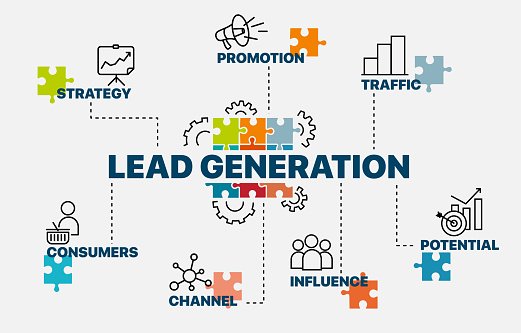Lead Generation
What is Lead Generation?
Lead generation involves creating awareness and interest in your offerings, then capturing details (like names, emails, or phone numbers) to build a list of prospects. These leads can then be nurtured through follow-ups, personalized communication, or targeted campaigns until they’re ready to make a purchase. It’s the bridge between initial curiosity and a committed customer.
Key Steps in Lead Generation
- Identify Your Target Audience: Understand who your ideal customers are—demographics, interests, pain points, and behaviors—to tailor your approach effectively.
- Attract Prospects: Use marketing tactics to draw attention, such as:
- Content Marketing: Blogs, eBooks, whitepapers, or videos that provide value and address customer needs.
- Social Media: Engaging posts, ads, or campaigns on platforms like X, LinkedIn, or Instagram.
- Search Engine Optimization (SEO): Optimizing your website to rank higher on Google for relevant keywords.
- Paid Advertising: Google Ads, social media ads, or display ads to reach a broader audience quickly.
- Capture Leads: Offer something compelling (a lead magnet) in exchange for contact details, such as:
- Free trials, webinars, discounts, or downloadable resources.
- Landing pages with forms or pop-ups on your website.
- Nurture Leads: Build relationships through email marketing, personalized offers, or follow-up calls to move them toward a purchase decision.
- Qualify Leads: Assess which leads are most likely to convert (e.g., Marketing Qualified Leads or Sales Qualified Leads) to focus your efforts efficiently.
Types of Lead Generation
- Inbound: Prospects come to you organically through content, SEO, or referrals—cost-effective but slower.
- Outbound: You proactively reach out via cold emails, calls, or ads—faster but often more expensive.
- Online: Websites, social media, and digital ads dominate modern lead gen.
- Offline: Events, trade shows, or direct mail still work for specific industries.


Tools and Techniques
- CRM Software: Tools like HubSpot, Salesforce, or Zoho manage and track leads.
- Analytics: Google Analytics or social media insights to measure campaign success.
- Automation: Email drip campaigns or chatbots to streamline nurturing.
- X and Web Search: Analyze trends, competitor strategies, or customer conversations for insights (e.g., I could search X posts for real-time lead gen tips if you’d like).
Why It Matters
Lead generation fuels business growth by creating a pipeline of potential customers. It’s cost-effective compared to mass advertising, as it targets those already interested, increasing conversion rates. For startups or small firms (like a Pvt Ltd, LLP, or Proprietorship), it’s a scalable way to compete without massive budgets.
Challenges
- Quality vs. Quantity: Too many leads can dilute focus if they’re not relevant.
- Competition: Standing out in crowded markets requires creativity.
- Compliance: In India, for instance, GST-registered businesses must align lead gen with tax and data privacy laws (e.g., avoiding spam under TRAI rules).
Types of Lead Generation
Inbound Lead Generation
- Attracts leads organically through content and value-driven strategies.
- Examples: Blog posts, SEO-optimized websites, eBooks, webinars, social media content.
- Pros: Builds trust, cost-effective long-term.
- Cons: Slower to yield results, requires consistent effort.
- Outbound Lead Generation
- Proactively reaches out to potential leads via direct contact.
- Examples: Cold calling, email blasts, direct mail, paid ads (e.g., Google Ads, billboards).
- Pros: Quick results, targeted outreach.
- Cons: Higher cost, lower conversion if not personalized.
- Content Marketing Lead Generation
- Uses valuable content to draw in leads who willingly share contact info.
- Examples: Whitepapers, case studies, gated content (e.g., downloadable PDFs for email signups).
- Pros: Establishes authority, nurtures leads.
- Cons: Needs high-quality content, time-intensive.
- Social Media Lead Generation
- Leverages platforms like Facebook, LinkedIn, or Instagram to capture leads.
- Examples: Lead ads (e.g., Facebook Lead Forms), contests, organic posts with CTAs.
- Pros: Wide reach, engaging formats.
- Cons: Platform-dependent, requires ad spend for scale.
- Email Marketing Lead Generation
- Builds leads through targeted email campaigns or opt-in forms.
- Examples: Newsletters, drip campaigns, free trial offers.
- Pros: Direct communication, high ROI.
- Cons: Needs a solid list, risks spam complaints.
- Event-Based Lead Generation
- Collects leads through physical or virtual events.
- Examples: Trade shows, webinars, workshops, networking meetups.
- Pros: Personal interaction, qualified leads.
- Cons: Resource-heavy, limited scale.
- Referral Lead Generation
- Generates leads through word-of-mouth or customer recommendations.
- Examples: Referral programs (e.g., “Refer a friend, get $10”), affiliate marketing.
- Pros: High trust factor, low cost.
- Cons: Relies on existing customers, slower growth.
- Paid Advertising Lead Generation
- Uses paid channels to drive immediate lead capture.
- Examples: Pay-per-click (PPC) ads, social media ads, display banners.
- Pros: Fast, measurable results.
- Cons: Expensive, stops when budget runs out.
- Local Lead Generation
- Targets leads in a specific geographic area, often tied to local SEO.
- Examples: Google Business Profile optimization, local directories, “near me” ads.
- Pros: High intent, great for small businesses.
- Cons: Limited to local market, needs consistent updates.
- Search Engine Lead Generation
- Captures leads via search engine visibility, overlapping with SEO.
- Examples: Ranking for high-intent keywords (e.g., “buy laptops online”), landing pages.
- Pros: Cost-effective, scalable.
- Cons: Competitive, takes time to rank.
